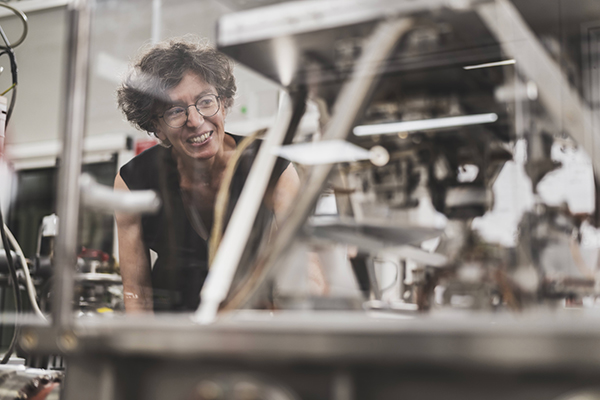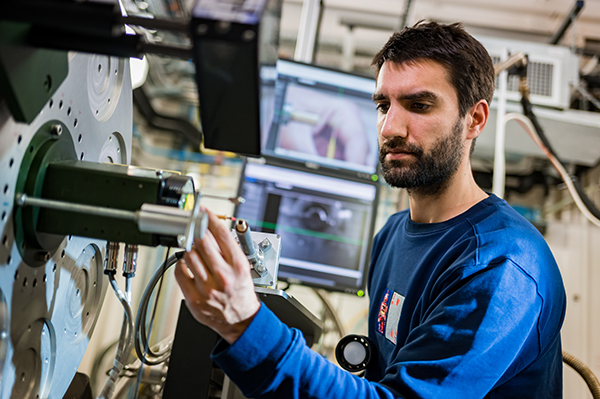- Home
- News
- General News
- Scientists uncover...
Scientists uncover a rare component in Da Vinci’s Mona Lisa paint
12-10-2023
Leonardo Da Vinci experimented with innovative painting techniques in his oil paintings. Scientists have just detected the presence of an unusual, rare and unstable component, plumbonacrite, in Mona Lisa’s painting. The artist probably endeavored to prepare a thick paint to cover the wooden panel of the Mona Lisa. The results are published today in JACS.
Leonardo da Vinci (1452-1519) is considered one of the most important figures of the Renaissance. Whilst he wrote numerous manuscripts bearing on his many sources of interest such as engineering or architecture, he left very few clues on his painting materials. His taste for experimentation was strikingly present in his craft: The build-up of the different layers in each of his paintings is different, as are the materials used.
Now researchers from the laboratory Photophysique et photochimie supramoléculaires et macromoléculaires (CNRS/ENS Paris-Saclay), the Institut de recherche de chimie Paris (CNRS/Chimie ParisTech – PSL), the Centre de recherche et de restauration des musées de France (Ministère de la culture), the Louvre Museum, the Laboratoire d’archéologie moléculaire et structurale (CNRS/Sorbonne Université) and the ESRF, the European Synchrotron, have studied a microsample of the preparation layer of the Mona Lisa to shed light on Da Vinci’s painting methods. To get more clues about Da Vinci’s palette and technique, they also analysed several fragments from the Last Supper, another masterpiece by Leonardo.
The team used the techniques of synchrotron radiation high-angular resolution X-ray powder diffraction (SR-HR-XRPD), micro X-ray diffraction (µXRD) and micro Fourier-transform infrared spectroscopy (μ-FTIR) at the ESRF’s ID22, ID13 and ID21 beamlines, respectively. The results show the presence of a very uncommon composition in both the Mona Lisa’s ground layer and the Last Supper’s ground and paint layers.
 |
 |
|
Marine Cotte (left) and Victor Gonzalez (right) on the beamlines. Credits: S. Candé (left) and B. Lavit (right). |
|
“In Mona Lisa, we found a relatively high amount of plumbonacrite, an unusual compound that we think is due to a specific mix of oil with lead oxide”, explains Victor Gonzalez, researcher at the laboratory Photophysique et photochimie supramoléculaires et macromoléculaires (CNRS/ENS Paris-Saclay) and corresponding author of the publication. However, the team had seen this component before, specifically in Rembrandt’s masterpiece The Night Watch, painted two centuries after the Mona Lisa. This enabled the scientists to identify possible hypothesis to explain its presence despite the chronological differences between the two artists.
“We faced the additional challenge that there are very few scientific analysis of Mona Lisa and of Da Vinci’s paintings in general, so it was difficult to compare our results with previous studies”, explains Marine Cotte, scientist at the ESRF and co- author of the publication.
Finally, the scientists analysed the manuscripts and translations of Leonardo's recipes. “This was incredibly difficult because the words that Leonardo used are very different from present terminology and because of the gap between terms used in paintings and in chemistry”, explains Cotte. Eventually, they found the referral to a chemical compound in one of Da Vinci’s recipe. It was mentioned in the context of a pharmaceutical practice, but scientists understand that he may also have used it in paintings. “It is important to take a multidisciplinary approach in this field: The analysis of model samples prepared following historical treatises was also crucial to our conclusions in the paper”, explains Ida Fazlic, ESRF PhD student and co-author of the publication.
“With this study, we provide key elements to understand Da Vinci’s recipes and the evolution of his paintings throughout time”, says Gonzalez. “The results of the research show that he experimented with the preparation of thick and opaque ground layers”, he concludes.
This research has benefited from the Cultural Heritage Block Allocation Group (BAG), a new access mode at the ESRF that allows the cultural heritage community to get group access to beamtime on a regular basis, meaning that several experiments can take place in a single session.
Reference:
Gonzalez, V., et al, JACS, 11 October 2023. https://doi.org/10.1021/jacs.3c07000
Top image: Artistic impression of the Mona Lisa. Credits: I. Fazlic, M. Cotte & V. Gonzalez.



